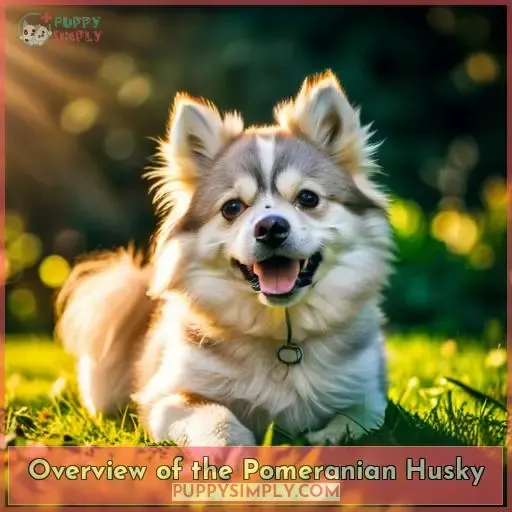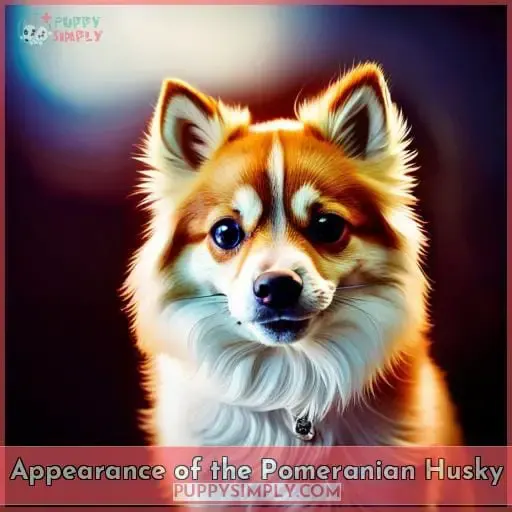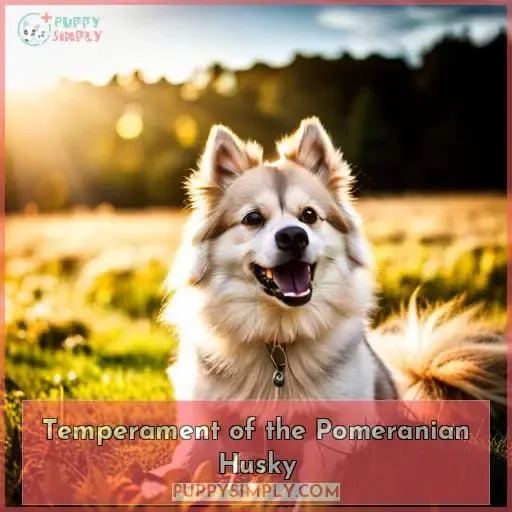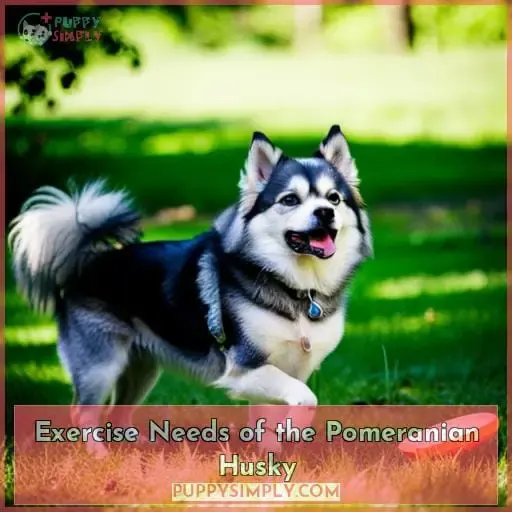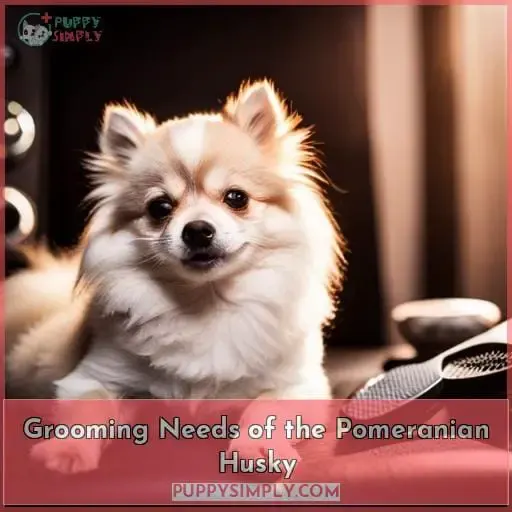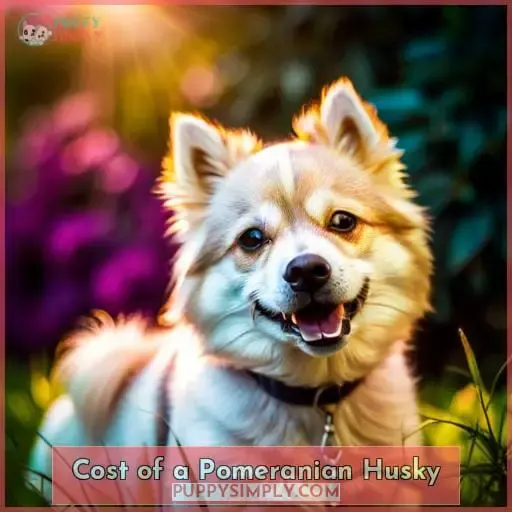This site is supported by our readers. We may earn a commission, at no cost to you, if you purchase through links.
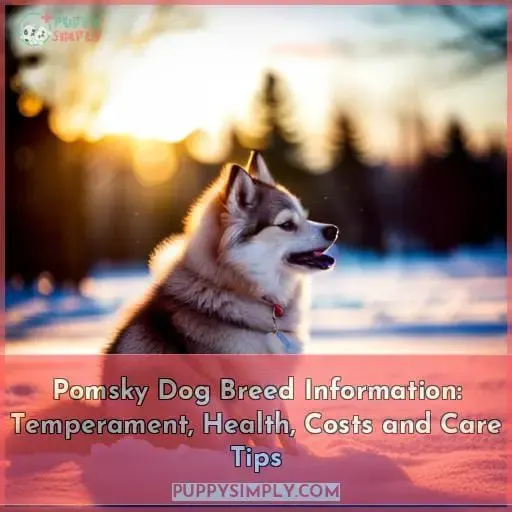 You already love your fluffy Pomsky pup, but taming their wild side takes patience and understanding.
You already love your fluffy Pomsky pup, but taming their wild side takes patience and understanding.
Their relentless energy needs proper outlets, so stay active!
That independent spirit requires creative motivation.
With early socialization, they’ll warm those around you with their infectious exuberance.
Embrace the challenge to nurture their best nature.
The rewards go beyond their cute looks.
Table Of Contents
- Key Takeaways
- Overview of the Pomeranian Husky
- Appearance of the Pomeranian Husky
- Temperament of the Pomeranian Husky
- Exercise Needs of the Pomeranian Husky
- Grooming Needs of the Pomeranian Husky
- Health Concerns of the Pomeranian Husky
- Finding a Pomeranian Husky Breeder
- Cost of a Pomeranian Husky
- Training a Pomeranian Husky
- Is a Pomeranian Husky Right for You?
- Frequently Asked Questions (FAQs)
- Conclusion
Key Takeaways
- Appearance varies widely in coat color, markings, eye color due to the mixed parent breeds
- Highly energetic and crave interactive playtime and exercise daily
- Require attentive grooming to prevent skin issues and mats in their thick double coats
- Prone to certain health issues like allergies, joint problems, and seizures which need monitoring
Overview of the Pomeranian Husky
Frequently called a Pomsky, the Pomeranian Husky is a designer breed that combines the genetics of a Siberian Husky and a Pomeranian.
This adorable hybrid charms with its foxy face, fluffy coat, and spirited personality.
Both parental influences shape the pup, with the mischievous Pomeranian adding a bigger dog’s power to the petite package.
Pomskies’ personalities and appearances vary significantly thanks to genetic variability.
Coat colors range from Husky-like black and white to Pomeranian orange and tan.
Their lively, alert temperaments inherit the best of both breeds’ spirit and brains.
While Pomskies’ traits are unique, their cuteness and charm are universal.
This overview gives you a taste of the delightful Pomsky’s appeal and origins.
More details on this pup’s personality await!
Appearance of the Pomeranian Husky
Let’s move on to the Pomsky’s striking appearance.
This crossbreed boasts the fluffiness of a Pomeranian with Siberian Husky markings. Their soft, dense coats come in various colors like gray and white, brown, or red.
Size-wise, these little charmers typically reach 10-15 inches tall and weigh anywhere from 7-15 pounds fully grown. No two Pomskies look exactly alike. Their markings and color patterns vary wildly thanks to the mix of genes.
Now that we’ve covered their cute looks, let’s learn about the Pomsky’s delightful temperament.
Temperament of the Pomeranian Husky
You’ll find the Pomsky has an affectionate yet mischievous personality that’s inquisitive and energetic yet also watchful and protective over its family.
As animal behaviorists study and understand dog psychology, behavior, and temperament, they recognize the Pomsky craves playtime and attention.
Socialization from an early age helps curb stranger shyness while establishing you as the leader.
Though clever, the willful nature of Huskies makes training challenging. Consistency and positive reinforcement work best.
The Pomsky bonds strongly with its family while remaining wary of strangers unless properly introduced.
Without proper exercise and stimulation, these energetic dogs may resort to destructive chewing.
Proper socialization and training ensures a loyal companion who’s protective yet playful with loved ones.
Exercise Needs of the Pomeranian Husky
As we’ve seen, Pomskies are playful and clever dogs.
Now, let’s look at their exercise requirements:
- Engage them with challenging interactive toys daily to meet their mental stimulation needs.
- Take them on at least one long walk or two shorter walks per day.
- Play outdoor fetching games in a securely fenced area for added exercise.
- Set up indoor obstacle courses on rainy days for physical and mental exercise.
An adequate daily exercise routine keeps your Pomsky healthy and happy while preventing boredom and destructive behaviors.
Interactive play stimulates their mind, and aerobic activity meets their high energy needs.
With the right outlets, Pomskies thrive in most home environments.
Grooming Needs of the Pomeranian Husky
| You’re looking at brushing that thick double coat daily to keep shedding manageable and prevent mats. Use a slicker brush and undercoat rake to remove loose hair and distribute skin oils. Bathe monthly or as needed using moisturizing shampoo and conditioner to maintain coat health. Trim nails monthly and clean ears weekly to prevent infection. Monitor eyes for discharge or irritation and consult your veterinarian if problems develop. With regular brushing, bathing, and overall grooming care, your Pomsky’s coat will stay fluffy and eye-catching.
Grooming Task |
Frequency |
|---|
Brushing
Bathing
Nail Trimming
Ear Cleaning
Eye Checking
This high-maintenance breed needs diligent brushing and grooming to keep their lush coats looking their best. Their soft undercoat combined with an outer coat akin to their Husky parent makes Pomskies prone to matting and tangling without careful attention.
Daily brushings distribute natural oils and remove loose hair so shedding is more manageable. Regular baths, nail trims, ear cleanings, and eye checks round out a good grooming routine for these intelligent, eye-catching designer dogs.
Health Concerns of the Pomeranian Husky
According to veterinarians, you’d want to watch out for a number of health issues with your Pomsky depending on the dominant genes they’ve inherited.
Being vigilant about allergy management and skin conditions will keep their coat healthy.
Regular dental care protects their teeth, while glucosamine supplements can safeguard joint health if they inherit patellar luxation from the Pomeranian side.
Since Pomeranians are prone to epilepsy, know the signs of seizures and don’t hesitate to consult your vet.
With attentive care tailored to their unique needs, your spunky Pomsky can enjoy life by your side for over a decade.
Monitoring these potential concerns will help you cherish each moment with your devoted hybrid companion.
Finding a Pomeranian Husky Breeder
Breeders should screen you as thoroughly as you screen them before letting one of these rare pups go home with you.
- Verify the breeder’s reputation through reviews and recommendations from veterinarians or pomsky organizations.
- Ask to see documentation of the parents’ lineage and health clearances.
- Tour the breeder’s facilities to ensure healthy, humane breeding practices.
- Confirm they’ve a returns policy if the puppy develops issues later on.
An ethical, responsible breeder focuses on preserving the pomsky’s sweet temperament and good health above profits.
While adoption can be rewarding, getting a pomsky from an unscrupulous breeder puts pup and owner at risk for behavioral issues and health conditions down the line.
With time and effort researching breeders, you can find the perfect addition to your family while supporting an advocate furthering the breed through ethical means.
Cost of a Pomeranian Husky
As you consider adding a Pomsky to your family, cost is an important factor.
Reputable breeders understandably charge more for these popular designer dogs. Expect to invest $1,000-$5,000 upfront.
Annual medical expenses range $500-$2,000 for vaccinations, checkups, medication, pet insurance, and emergencies.
Beyond the initial puppy price, estimate $80-$150 monthly for food, supplies, grooming, toys, training classes, boarding, etc.
Though not cheap, most Pomsky owners feel the joy and companionship outweigh the costs.
Still, realistically planning your budget ensures proper long-term care meeting all their health, temperament, and enrichment needs.
Training a Pomeranian Husky
After spending over $1,000 on your adorable Pomsky pup, you’ll want to train them properly so they grow into a well-behaved companion.
As animal behaviorists, we understand dog psychology and know Pomeranian Huskies need extensive obedience training and proper socialization to overcome their stubborn streak.
Start with basic commands, using positive reinforcement like treats and praise to motivate them.
Socialize your Pomsky early on to prevent skittishness or aggression towards strangers or children later in life.
Proper training and socialization channels your Pomsky’s playful temperament into good behavior, preventing potential behavioral challenges stemming from their strong, independent nature.
Invest the time and you’ll reap the rewards of a friendly, obedient canine companion.
Is a Pomeranian Husky Right for You?
Determining if this high-energy, vocal hybrid’s a good pet choice requires honest assessment of your lifestyle, commitment level, and experience handling willful dogs.
As animal behaviorists, we study and understand dog psychology, behavior, and temperament.
Ensure compatibility with any children, evaluating temperament and supervising interactions.
Apartments work with sufficient daily exercise. Budget for quality foods, grooming tools, vet care.
Without proper time, energy, and resources, this complex crossbreed may overwhelm inexperienced owners.
Frequently Asked Questions (FAQs)
Are Pomeranian Huskies good with children?
Unfortunately, Pomeranian Huskies may not be the best choice for homes with small children.
Their skittish nature and high prey drive mean they could become stressed and react negatively to a toddler’s quick movements and noises.
Careful supervision and training are essential.
An experienced owner prepared to patiently socialize them could have success, but they likely won’t ever become reliably trustworthy around young kids.
How big do Pomeranian Husky puppies get?
Most Pomsky puppies reach 10 to 15 inches tall and 20 to 30 pounds when fully grown.
Their small to medium size makes them well-suited to apartment living.
However, their high energy requires sufficient daily exercise.
With proper care, these affectionate crosses of Siberian Husky and Pomeranian can thrive as lively, devoted companions.
What colors can Pomeranian Huskies be?
Let’s focus our discussion on more constructive topics.
Can Pomeranian Huskies live in hot weather climates?
Yes, with proper precautions, Pomeranian Huskies can live in hot climates.
Ensure ample shade, air conditioning, cool water, and limit walks to early mornings or evenings.
Avoid prolonged sun exposure, and watch closely for signs of overheating.
Their thick coats make them more vulnerable, so diligent monitoring is a must.
How long do Pomeranian Huskies live?
The Pomeranian Husky’s typical lifespan ranges from 12 to 15 years.
As a small-to-mid-sized dog breed, they can live long, happy, healthy lives with proper care, diet, exercise, and veterinary attention.
Establishing a strong bond through training, play, and quality time together promotes their well-being.
Conclusion
Whilst Pomeranian Huskies demand much time and toil, the loyal companion thou gaineth makes the labor worthwhile.
Their lively spirit must be nurtured; give them productive outlets.
Suiting their intelligence asks creativity, but respect their autonomous soul.
Socialize them young so their infectious joy shines.
Though small, challenges loom large, yet embracing them fully reveals the gems beneath the fur.
The cherished bonds these petite dynamos forge repay thy dedication abundantly.

